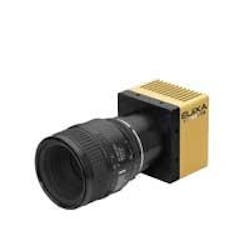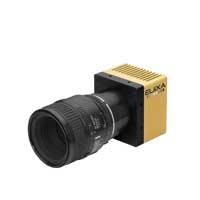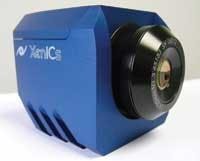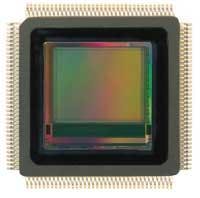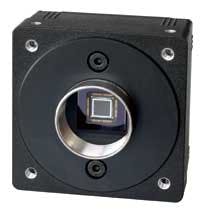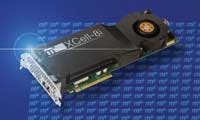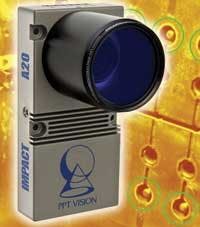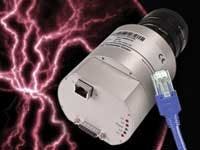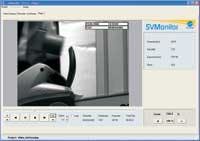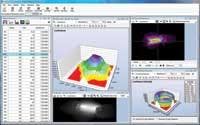Vision + Automation Products
Two monochrome models, the 4S and 3V, have been added to the EliiXA industrial linescan camera range. The 4096-pixel multiline monochrome camera delivers scene grab rates of up to 54 KHz and expanded spectral response. The 4S monochrome model is suited for low light use. The 3V model’s multiline sensor physically operates each individual line; simultaneously, a patented process re-orders the lines, making the camera behave like a single-line camera. Camera Link interface, various trigger modes, multiple output modes, and bidirectional scanning are standard.
e2v, Biévres, France, www.e2v.com
System uses chromatic confocal sensor
The measurement line of the MPLS180 contactless measurement system is composed of 180 independent measurement points and is able to measure up to 1800 lines/s (a point measuring rate of 324 kHz). It includes 180 embedded spectrographs. The chromatic confocal sensor is composed of an optoelectronic controller; a bundle of optical fibers linking the controller with the optical head; and an optical head, with scanning mirror.
STIL, Aix-en-Provence, France, www.stilsa.com
Smart IR camera processes images internally
The Xenics Gobi-384 smart infrared camera combines a camera head including lens with on-board DSP-based control and communication, TCP/IP and Camera Link interfaces, and a video interface. Primary applications are thermal imaging in machine vision R&D; medical, automotive, maritime, and aviation industries; and noncontact temperature measurement and hyperspectral imaging. Camera is based on an uncooled microbolometer array, delivering 384 × 288 pixels on a 25-µm pixel pitch. Image processing takes place inside the camera using 16-bit ADCs.
XenICs, Leuven, Belgium, www.xenics.com
Sensor captures, outputs images simultaneously
A1312 series third-generation sensors are designed and fabricated using a 0.35-µm CMOS technology with 1312 × 1082-pixel resolution (8 × 8-µm square pixels) and over 60% fill factor. The fastest version of the sensor delivers 110 frames/s at full resolution. Dynamic range is extended up to 120 dB with patented LinLog technology. The sensors can begin to capture a new image while outputting the current image. Spectral range covers 350 to 1000nm. An inorganic antireflective coating reduces the amount of light reflected back from the sensor surface.
Photonfocus
Lachen, Switzerland
www.photonfocus.com
1-Mpixel camera performs at 120 frames/s
The aviator camera series features two new camera models based on Kodak’s new KAI-01050 CCD sensor. The first models feature 1-Mpixel resolution (1024 × 1024 pixels) at 120 frames/s. Progressive-scan readout and global shutter technology are implemented in a 62 × 62 × 57-mm housing. Applications include semiconductor manufacturing, electronics manufacturing, metrology, and medical imaging. Image quality is measured and proven for each camera by automated EMVA 1288 sensitivity tests performed during production. Available in monochrome or color, standard cameras are equipped with a C-mount adapter; CS-mount versions will also be available.
Basler Components
Ahrensburg, Germany
www.baslerweb.com
PC processor powers accelerator board
The mvXCell-8i PCIe accelerator board uses the IBM PowerXCell 8i processor. The latest Cell/B.E. (Cell Broadband Engine) PowerXCell 8i processor has a standard core (PPE) working as manager and eight cores (SPEs) optimized for fast parallel processing of pixel and DP float data. On the board, all nine cores work with 2.8 GHz, allowing the board to reach 180 Gflops single precision and 90 Gflops double precision float. Memory includes 4 Gbytes of DDR-RAM. The mvXCell-8i can be used as an accelerator board for Windows and Linux systems or as a standalone Linux computer. Two GigE ports enable direct connection of GigE Vision cameras. Several boards can be configured as preprocessing devices in a PC.
Matrix Vision
Oppenweiler, Germany
www.matrix-vision.de
Smart camera directly interacts with PLCs and other automation equipment
Designed for harsh environments, the Matrox Iris GT smart camera is powered by an Intel 1.6-GHz Atom processor and runs Windows CE 6.0. An integrated graphics controller features VGA output, 256-Mbyte DDR2 memory, and 1 Gbyte of flash memory. A 10/100/1000 Ethernet port, USB 2.0 port, RS-232 serial port, optocoupled trigger input, and strobe output provide connectivity to external devices. Iris GT supports Ethernet/IP and Modbus over TCP/IP communications to directly interact with PLCs and other automation equipment. The camera is available in two sensor configurations: 640 × 480 at 110 frames/s 1/3-in. monochrome CCD and 1280 × 960 at 22 frames/s 1/3-in. monochrome CCD. Iris GT is available either with the Matrox Design Assistant interactive development environment (bundled with each unit) or the Matrox Imaging Library (sold separately).
Matrox Imaging
Dorval, QC, Canada
www.matrox.com/imaging
Mold protection system operates in ‘head-less’ mode
The Sentinel Mold Protection Solution protects mold presses and tooling from damage due to sticky slides and molded parts that are not ejected properly. A complete Sentinel Mold Protection Solution consists of one to four IMPACT cameras, application-specific infrared LED lighting and lens, Sentinel software, and all required interconnecting components that interface with the mold press. Software panels are preconfigured for mold protection applications; users point and click to select the desired inspection options before putting the system online. Sentinel also supports “head-less” mode operation, enabling disconnection of the PC after configuration. Smart cameras are interfaced directly with the press control so the system continues to monitor the press, alerting operators to problems.
PPT Vision
Bloomington, MN, USA
www.pptvision.com
Camera’s FPA sensor providessensitivity of 0.9–1.70 m
The OWL SW1.7 uses SWIR sensor technology for day/night surveillance performance. Featuring a high-sensitivity InGaAs FPA sensor developed by Alcatel-Thales III-V lab, the camera offers 320 × 256-pixel resolution, with pixel pitch of 30 × 30 μm. Response sensitivity is in the range from 0.9–1.70 m, allowing exposure time from 500 ns to 500 ms for optimum image quality in all conditions. It is suitable for passive surveillance, thermal imaging of hot objects (in a range of 150°–800°C), night-vision driver viewing, and low-light imaging scientific applications. The lightweight, ultracompact camera includes RS-485 communication.
Raptor Photonics
Larne, UK
www.raptorphotonics.com
GigE camera improves light sensitivity by factor of four
The HCC-1000B Gigabit Ethernet camera has increased light sensitivity by a factor of four. The camera can be operated via typical Ethernet cable at each suitable PC or notebook at long distances. It features internal dark image correction, C-mount compatible sensor size, and output frame rates of 30 and 200 frames/s for the HC-1000BGE and HC-1000FBGE, respectively.
VDS Vosskühler
Osnabrück, Germany
www.vdsvossk.de
Recorder responds to various signal triggers
The SVMonitor high-speed recording system is able to record and store videos with or without a time stamp and is compatible with Gigabit Ethernet, Camera Link, FireWire, and USB 2.0 interfaces. SVMonitor can display recorded sequences forward and backward, as well as in a user-defined speed (e.g., slow motion). Both start and stop as well as single pictures can be triggered through various external signals (e.g., by software, hardware signals, changes within a picture, or absolute and relative time). A life mode for setup and focusing of the camera as well as a zoom function are also available. Depending on size and speed of the hard disk used, sequences up to several hours can be recorded either compressed or uncompressed. Single images in a sequence can be stored for documentation purposes.
SVS-VISTEK
Seefeld, Germany
www.svs-vistek.com
Light-source analysis tool covers emerging LED applications
ProSource 8.0 software offers light-source nearfield data analysis and ray generation. It is intended for use by light source and lighting system designers and developers and applies to all light sources, including emerging LED applications. ProSource 8.0 includes improvements to nearly all areas of the software. A new interface and graphics allow users to rapidly access and analyze Radiant Source Model (RSM) information. Window docking and tabbing simplify organization of data representations and operations that result during a typical session. Users can control the number of rays generated, angular range of the rays, total luminous flux of the ray set, and ray origin. The program can generate full color ray set data for export.
Radiant Imaging
Duvall, WA, USA
www.radiantimaging.com
Scanner operates at 1200 scans/s
In a footprint of 22 × 30 × 40 mm, the VB6-240 barcode scanner delivers 0.15-mm (6-mil) resolution to read very small labels and operates at a speed up to 1200 scans/s. A built-in ACR (Automatic Code Reconstruction) embedded software algorithm allows the scanner to decode damaged or normally unreadable codes. Test operating mode, with a built-in bar graph display, is activated by means of a pushbutton on the scanner (external PC not required), with an LED bar graph that indicates the real-time read percentage.
Pepperl+Fuchs
Twinsburg, OH, USA
www.pepperl-fuchs.com
